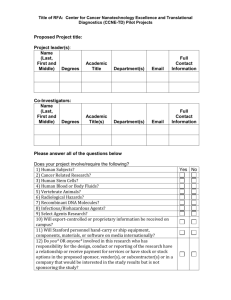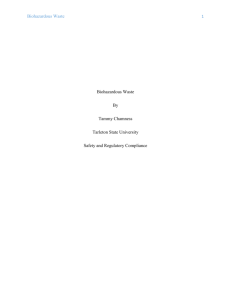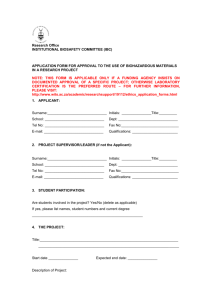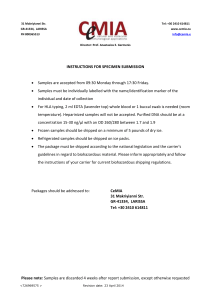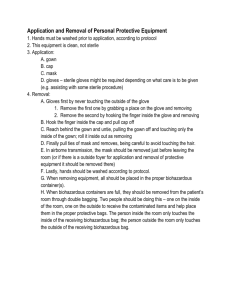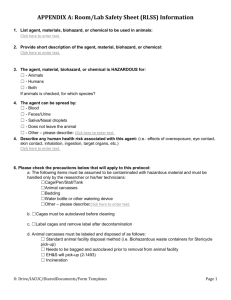Central Michigan University
advertisement
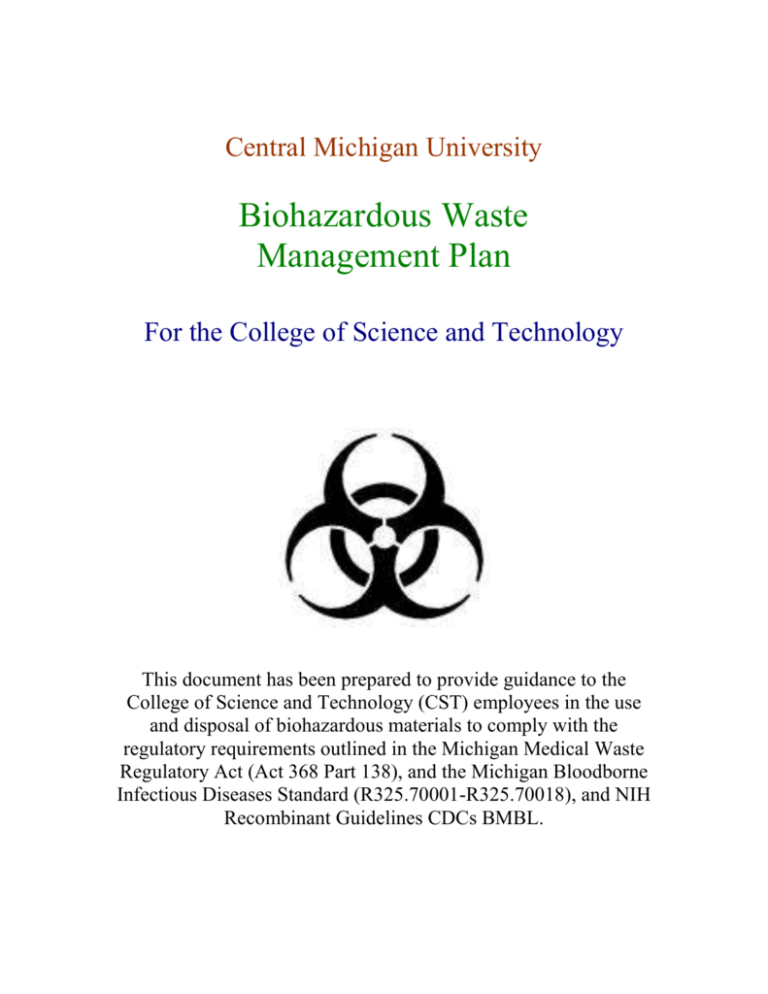
Central Michigan University Biohazardous Waste Management Plan For the College of Science and Technology This document has been prepared to provide guidance to the College of Science and Technology (CST) employees in the use and disposal of biohazardous materials to comply with the regulatory requirements outlined in the Michigan Medical Waste Regulatory Act (Act 368 Part 138), and the Michigan Bloodborne Infectious Diseases Standard (R325.70001-R325.70018), and NIH Recombinant Guidelines CDCs BMBL. Biohazardous Waste Management Plan Table of Contents Section Introduction General Program Management Page Number Areas of Responsibility Biohazardous Waste Management Plan Availability 3 4 4 6 Biohazardous Waste-CST Types of Biohazardous Waste Generated and /or Handled Segregation, Packaging, Labeling and Collection of Biohazardous Waste Methods of On-Site Storage Methods of On-Site Decontamination Disposal Exposure Minimization Methods for Employees Involved in Biohazadous Waste Generation, Handling and Disposal Biohazardous Waste Training 6 6 9 9 10 10 11 Appendices Appendix A: Biohazardous Waste Contact Information Appendix B: Biohazard Waste Tag 12 13 2 Introduction The College of Science and Technology (CST) at Central Michigan University defines the term “biohazardous waste” as any discarded materials which might include infectious agents or laboratory disposed materials regulated by federal, state, and local authorities. The following waste categories are considered to be biohazardous waste and are covered by the provisions of the CST Biohazardous Waste Management Plan (BWMP). According to the MMWRA, medical waste includes: 1. Cultures and stocks of infectious agents and associated biologicals, including laboratory waste, biological production waste, discarded live and attenuated viruses, culture dishes, and related devices. 2. Liquid human and animal waste, including blood and blood products and body fluids, but not including urine or materials stained with blood or body fluids. Pathological waste: a.) defined as human organs, tissues, body parts other than teeth, products of conception, and fluids. removed by trauma or during surgery, autopsy or other medical procedure, and not chemically-fixed (i.e. formaldehyde). b.) animal carcasses, organs, tissues, and body parts. 3. Sharps: defined as needles, syringes, scalpels, and intravenous tubing with needles attached regardless of whether they are contaminated or not. Additionally, any object that is contaminated and sharp enough to puncture the skin (i.e. microscope slides, lab slides, cover slips, etc.). 4. Contaminated wastes from animals that have been exposed to agents infectious to humans, these being primarily research animals. Regulated waste as defined by the Michigan Occupational Safety Health Administration (MIOSHA) Blood borne Infectious Diseases Standard including: 1. Liquid or semi-liquid blood or potentially infectious materials; 3 2. Contaminated items that would release blood or other potentially infectious materials in a liquid or semi-liquid state if compressed; 3. Items that are caked with dried blood or other potentially infectious materials and are capable of releasing these materials during handling; 4. Contaminated sharps which includes any contaminated object that can penetrate the skin and cause infection; 5. Pathological and microbiological wastes containing blood or other potentially infectious materials. Laboratory waste and regulated waste as defined in the NIH Guidelines for Research Involving Recombinant DNA Molecules and the CDC/NIH Biosafety in Microbiological and Biomedical Laboratories. In general, this category includes contaminated waste that is potentially infectious and /or hazardous to humans, animals, or plants. CST requires that all employees involved in the generation, handling and disposal of biohazardous waste comply with the provisions of the Biohazardous Waste Management Plan. This plan is used in conjunction with the CMU Hazardous Waste Disposal Guide. General Program Management Areas of Responsibility The proper segregation, treatment and disposal of biohazardous waste can only be achieved through the cooperation of all responsible CST personnel. This division of responsibilities includes: 1. The Biological Safety, Radiation, and Chemical Coordinators; in conjunction with the Hazardous Waste Manager and the Animal Facility Coordinator or their designee; (refer to Appendix A for contact information). 2. Supervisory Personnel (including Department Chairs, Directors, Principal Investigators, Managers, and Supervisors). 3. Employees. 4 The CST Biological Safety Coordinator or designee will: Oversee the implementation of the Biohazardous Waste Management Plan; Develop, in coordination with administrators, additional biohazardous waste-related policies and procedures as needed to support the effective implementation of this plan and maintain compliance with regulatory requirements; Revise the plan within 30 days each time there is a change in the following: a. A person or site named in the plan; b. The type of waste handled, or the methods of handling waste in a CST facility; c. Applicable regulations. Supervisory Personnel Assure that all employees who generate, handle, treat and /or dispose of biohazardous waste receive biohazardous waste training as outlined below; Assure that all employees under their supervision who generate, handle, treat and /or dispose of biohazardous waste follow the procedures outlined in this plan. Employees Employees who generate, handle, treat, and/or dispose of biohazardous waste are responsible for: Following the procedures and practices outlined in this document; Receive appropriate training for handling biohazardous waste. 5 Biohazardous Waste Management Plan Availability The Biohazardous Waste Management Plan is available to all CST employees. CST employees can request a copy by calling the Biological Safety Coordinator at 774-3279. A copy will be provided within 2-4 working days of the request. The BWMP is available at this web address: http://www.cst.cmich.edu/users/schul1te/ Biohazardous Waste Potential Types of Biohazardous Waste Generated and /or Handled by the College of Science and Technology 1. Cultures and stocks of infectious agents and associated biologicals, including laboratory waste, biological production wastes, culture dishes, and related devices. 2. Liquid human and animal waste, including blood, blood products and body fluids, but not including urine or materials stained with blood or body fluids. 3. Research or teaching animal carcasses, organs and body parts. 4. Sharps, which means needles, syringes, scalpels, or any item sharp enough to penetrate the skin and is contaminated with potentially infectious material. 5. Wastes generated in recombinant DNA research. 6. Animal carcasses and wastes (i.e. bedding) generated while conducting infectious disease or recombinant DNA research. Segregation, Packaging, Labeling, and Collection of Biohazardous Waste A. General Methods 1. Biohazardous waste is to be packaged, or contained and located in a manner that prevents and protects the waste from release at the producing facility at any time before ultimate disposal. 6 2. Primary containers (other than approved biohazard bags) used for biohazardous waste collection, storage and disposal are to be labeled with a biohazard symbol and/or the words “BIOHAZARDOUS WASTE” in letters not less than one inch high. The required background color of all primary containers is red or orange (e.g., biohazard bags). If the biohazard bag is used to collect liquids which may leak out of the bag, it must be placed in a secondary, leak-proof container with a biohazard sticker to meet all regulations. 3. All non-sharps waste containers are required to be labeled with a completed Materials Waste Tag (refer to Appendix B) B. Waste Type-Specific Management Methods 1. All liquid cultures and stocks of materials contaminated with infectious agents and associated biologicals, including laboratory waste, biological production wastes, discarded live and attenuated viruses and microorganisms, and recombinant DNA waste. Materials shall be stored in closable, puncture resistant, containers and decontaminated by autoclaving. After autoclaving, liquid decontaminated waste can be disposed of in a sanitary sewer if no other hazardous materials are present (e.g. chemicals and /or radioactive materials). For information on the special treatment of radioactive or chemical biohazardous waste, contact: CMU’s Radiation or Chemical Safety Officer 2. All solid cultures and stocks of materials contaminated with an infectious agent, culture dishes and related devices other than sharps, can be stored in leak-proof, biohazard bags prior to decontamination. If rupture of bags or leakage is possible, the use of a secondary leak-proof container or bag is advised. 3. Biohazardous wastes, with the exception of liquids and sharps, which have been decontaminated by autoclaving, may be disposed of in the dumpster if they are securely packaged in bags or containers and the biohazard warning labels have been removed or the container is clearly labeled as decontaminated biohazardous waste. Decontaminated waste in biohazardous bags with an “Autoclaved” bag 7 indicator must be placed inside a non see-through (opaque) plastic bag or other secondary non-transparent container (box) prior to disposal in the dumpster. It is imperative that the waste is sufficiently autoclaved (darkening of the indicator) prior to disposal. Only biohazard bags with the “Autoclaved” indicator are currently approved. These bags are available through the Biological Safety Coordinator. 4. All blood, blood products and body fluids shall be disposed of by one of the following methods: Chemical disinfection or autoclaving followed by flushing down a sanitary sewer Decontamination by autoclaving followed by disposal in the landfill 5. Disposal of animal waste (carcasses or tissue) is disposed of by incineration through Stericycle. Animal waste will be double bagged and place in a secondary container provided by Stericycle. 6. Animal carcasses generated in recombinant DNA research will be stored in leak-proof containers labeled with a biohazard sticker and disposed of by incineration through Stericycle. 7. Sharps will be disposed of by incineration through Stericycle. Place discarded needles and syringes into an approved sharps container. An approved sharps container is one that is leak proof, puncture-resistant, closable, bears the biohazard symbol and is manufactured as a sharps container (this does not include plastic bleach bottles, milk bottles, etc.). Do not clip, bend, break, or recap sharps. A sharps container must be permanently closed and then disposed of through Stericycle when: It is ¾ full, or within 90 days of the date that the first sharp was placed in it, whichever comes first. (Label sharps containers with the date that the first sharp is placed in the container as well as disposal date). Animal waste and sharps disposal are coordinated by the Animal Facility Coordinator who can provide you with additional containers to collect the waste materials. 8 8. All waste generated in recombinant DNA research will be stored, treated and disposed of in the same manner as comparable waste types (i.e. liquid, solid, sharps) generated in infectious disease research. Methods of Storage Biohazardous waste cannot be stored on the premises for more than 90 days. All containers and equipment (e.g. incubators, refrigerators) used for storage shall be labeled with the biohazard sticker and or symbol. The preferable background color of all primary medical waste containers is red or orange fluorescent (e.g., biohazard bags). Methods of Decontamination Decontamination by Autoclave 1. Biohazardous waste, other than sharps and animal carcasses may be decontaminated on-site by autoclaving. To use this on-site treatment method, personnel must use an autoclave that has been tested and approved for biohazardous waste decontamination. Routine spore strip (or equivalent) testing will be performed to demonstrate the effectiveness of the decontamination. A log book will be maintained of the test results and the parameters used to demonstrate effectiveness of the decontamination process. These parameters must be followed by all personnel using the autoclave for waste decontamination purposes. 2. For questions or more information, contact the Biological Safety Coordinator at 774-3279. 9 Disposal All autoclaved and decontaminated biohazardous waste will be disposed of in a type II sanitary landfill or incinerated. Central Michigan University utilizes approved and licensed waste disposal companies to transport and dispose of biohazardous waste. Currently CMU is utilizing: Stericycle 1901 Pine Avenue SE Warren, Ohio 44483 Phone: (330) 393-0385 Exposure Minimization Methods for Employees Involved in Biohazardous Waste Generation, Handling and Disposal In accordance with MIOSHA regulations, CMU has an Exposure Control Plan (ECP) for bloodborne pathogens. The ECP covers the protocols, training, personal protective equipment, and engineering controls required to prevent or control aerosols of bloodborne pathogens. Personnel are encouraged to visit the Environmental Safety Services website at: http://www.ess.cmich.edu/default.htm for information regarding BBP training and other safety related training programs available at Central Michigan University. Proposals for work with infectious agents or recombinant DNA must be approved through the Institutional Biosafety Committee (IBC). The IBC will not approve any work that does not comply with applicable regulations. 10 Biohazardous Waste Training All personnel who generate, handle or dispose of biohazardous waste must complete training in the provisions of this plan. The training topics will include: Purpose and overview of the CST Biohazardous Waste Management Plan: Types of biohazardous waste generated, treated or disposed of at the work site: Segregation, packaging, storage and transport of biohazardous waste that is generated, treated or disposed of at the work site; Treatment and disposal methods for biohazardous waste that is generated treated or disposed of at the work site. Contact the Biological Safety Coordinator at 774-3279 to receive the appropriate training. In accordance with the Michigan Medical Waste Regulatory Act, new personnel must complete biohazardous waste training before they assume duties that involve the handling of biohazardous waste. Employees will receive updated information when a change in the Biohazardous Waste Management Plan occurs that directly affects their duties. Training Records Training records will be maintained for all CST personnel completing biohazardous waste training. These records will include: Employee’s name Job classification Training date All training records will be maintained for a minimum of three years through CMU’s Environmental Safety Office / Risk Management. Acknowledgements: Thank you the Health Professions Department at CMU and Carol Stevens for providing the template for this document. 11 Appendix A Contact information: Biological Safety Coordinator: Tom Schultz, 774-3279 Chemical Hygiene Officer: Jennifer Walton, 774-4189 Radiation Safety Officer: Jennifer Walton, 774-4189 For information regarding packaging, storage, or pickup of animal waste or sharps for CST contact: Animal Facility Coordinator, Audrey Brown at 774-2469 Hazardous Waste (Chemical Waste Pickup) Manager: Jamie Stock, 774-3378 (submit Hazardous Waste Form, on the web) Environment Safety Officer/Risk Management (Blood borne Pathogen training): Jon Kujat, 774-7398 For information regarding the management of biohazardous waste contact: Tom Schultz 774-3279 For information regarding disposal post packaging contact Stericycle at 616-454-9405. Schedule: Stericycle pickups are scheduled every 90 days. Contact Audrey Brown 774-269 for scheduled dates and/or changes to the schedule. Items for disposal must be placed in the designated areas (the freezer in BR118 or cold storage room BR105A) no later than the day before the scheduled pickup date in order to be processed, labeled, properly boxed and ready for pickup on the scheduled date. 12 Appendix B Biohazardous Waste Tag Project Leader________________ Dept.________________ Building & Room No.__________ Phone_______________ Filled out by__________________ Date________________ Container Size__________ Solid____ Liquid_____ Contaminated_____ Contents: Unabbreviated Chemical Name Amount or Approx. Conc. (ppm) __________________________ ________________________ _________________________ ________________________ _________________________ ________________________ Color_____ Colorless_____ Light Brown_____ Other______ Consistency____Waterlike_____Viscous/Oily_____Other_____ Biological and Animal Items: Category ___ Biohazardous Agents______ _______________________ _______________________ _______________________ ___ Chemically-contaminated animals or tissue. List chemical in ppm ____ Non-infectious, non-hazardous ____ Autoclaved Describe ____ Animals Type:_______ #:____ ____ Bedding, Feces, Feed ____Tissue or Blood Specimen ___ Plastics (syringes, vials, gloves, etc) Please indicate special handling or storage precautions on the back of this form: 13
